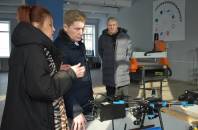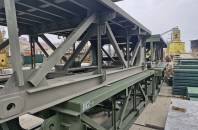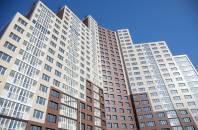|
Региональный журнал для деловых кругов Дальнего Востока
|
|
||||||||||||||||||||||
|
Понедельник| 20 Октября, 14:10 |
|
|
Тема номера
|
|||||||||||||||||||||

 Олег Кожемяко осуществил новогодние желания маленьких приморцев
В преддверии новогодних праздников заветные желания маленьких приморцев начинают сбываться. Так, Губернатор Приморского края Олег Кожемяко передал подарки от Деда Мороза двум маленьким приморцам: шестилетнему Мирону Глушаку из Тернейского муниципального округа и четырёхлетней Ольге Алимпиевой из Арсеньева.
Олег Кожемяко осуществил новогодние желания маленьких приморцев
В преддверии новогодних праздников заветные желания маленьких приморцев начинают сбываться. Так, Губернатор Приморского края Олег Кожемяко передал подарки от Деда Мороза двум маленьким приморцам: шестилетнему Мирону Глушаку из Тернейского муниципального округа и четырёхлетней Ольге Алимпиевой из Арсеньева.
 Родители ребят с ОВЗ обсудили вопросы образования и трудоустройства с представителями власти Приморья
Третья встреча клуба "На равных", призванного помогать гражданам решить непростые жизненные ситуации, состоялась в Приморье. В этот день участниками клуба стали родители детей с инвалидностью и ограниченными возможностями здоровья. Они обсудили с представителями власти вопросы образования и трудоустройства таких ребят.
Родители ребят с ОВЗ обсудили вопросы образования и трудоустройства с представителями власти Приморья
Третья встреча клуба "На равных", призванного помогать гражданам решить непростые жизненные ситуации, состоялась в Приморье. В этот день участниками клуба стали родители детей с инвалидностью и ограниченными возможностями здоровья. Они обсудили с представителями власти вопросы образования и трудоустройства таких ребят.
 Социальные предприниматели Приморья могут найти кадры и получить рекламу на радио при господдержке
Открыт прием заявок на две актуальные для социальных предпринимателей меры поддержки: "Размещение двух вакансий на HeadHunter" и "Размещение рекламы на радиостанции". Такой формат господдержки поможет социальному бизнесу Приморья продвигать свои услуги в осенний период и найти профессиональные кадры для расширения штата.
Социальные предприниматели Приморья могут найти кадры и получить рекламу на радио при господдержке
Открыт прием заявок на две актуальные для социальных предпринимателей меры поддержки: "Размещение двух вакансий на HeadHunter" и "Размещение рекламы на радиостанции". Такой формат господдержки поможет социальному бизнесу Приморья продвигать свои услуги в осенний период и найти профессиональные кадры для расширения штата.
 24 протокола составили на нарушителей противопожарного режима в приморских лесах
Лесничие и инспекторы в Приморье составили 24 протокола в отношении нарушителей особого противопожарного режима на землях лесного фонда. ОПР действует в большинстве муниципалитетов и подразумевает крупные штрафы за пренебрежение правилами пожарной безопасности.
24 протокола составили на нарушителей противопожарного режима в приморских лесах
Лесничие и инспекторы в Приморье составили 24 протокола в отношении нарушителей особого противопожарного режима на землях лесного фонда. ОПР действует в большинстве муниципалитетов и подразумевает крупные штрафы за пренебрежение правилами пожарной безопасности.
RFE investment climate
The RFE received double the Russian average per-capita amount of investment in 2011, seemingly an excellent result, and yet…
If we look at the sources of investment in the RFE, we see that most investment comes directly from federal spending (14.2%) or from government-controlled large companies, such as Gazprom, Transneft and Russian Railways, which accounted for more than half of all government funding outside the federal budget (81.3% of all investment spending). Federal funds went into development programs, preparations for Vladivostok hosting the APEC summit, while money from state companies was invested in megaprojects to be implemented under a federal mandate. Private investment in creating new companies and facilities and upgrading existing production facilities was fairly small, but it is private investment that serves as an objective “barometer” showing the quality of investment climate.
The situation with international investment is very similar. The RFE received USD 9.9 billion in foreign investment in 2011, a solid level of foreign investment, putting the RFE squarely among the Russian federal districts (in second place after the Central Federal District) by pe-capita foreign investment with USD 1,600 per resident, compared to the Russian average of USD 1,333. However, after excluding investment in Sakhalin oil and gas projects, which account for more than 70% of the total, the situation is reversed, with the remaining foreign investment at just USD 450 per capita. The Khabarovsk and Primorsky regions, which have the most developed manufacturing industry in the RFE, received less than USD 100 per capita of foreign investment.
The government relies on its own policies when making investment decisions or decisions to launch projects, while private investors look only at the ROI they can expect. We can see that there are very few incentives to encourage strong growth of private investment in capex, and regions in the RFE are fundamentally disadvantaged compared to other Russian federal districts.
The RFE occupies a vast area: 6.2 million sq. km, but its population is modest at just over 6 million concentrated in cities and towns that are sometimes thousands of kilometers apart. This makes the RFE consumer market an insignificant resource, while the cost of delivering goods and materials undermines the appeal of even local mineral resource deposits. Electric utilities face similar problems. Many areas do not have well developed power line grids or efficient sources of power generation, which makes power supply one of the biggest problems for the RFE: availability is poor and the price is high.
Electric power supply issues, combined with limitations of the road network, make many mineral resource extraction and processing projects a priori financially unviable. Construction of a mine or a processing or other production facility often costs only half or a third as much as building the essential power supply and transportation infrastructure to make its operation possible.
The harsh climate of the RFE makes doing business here more difficult, as it places greater, more stringent demands on essential utilities. There are parts of Chukotka, for example, where the heating has to be on every day, year round. This is to be expected in northern climes, but the heating season lasts more than six months in the majority of RFE regions, creating an extra burden on the business.
These are objective natural conditions which will always make the RFE look worse than other parts of Russia. Another negative is the weak potential of the local workforce. The RFE is currently the tightest market in the country in terms of the availability of quality labor.
For the RFE to become an attractive destination for a strong inflow of private investment, the conditions of doing business here should be at least on par with those nationwide. To achieve this, mechanisms would have to be developed to eliminate the existing infrastructure limitations - we need railroads and auto roads, reliable and efficient sources of electric power and power lines.
The government has attempted to take it upon itself to build the necessary infrastructure for some of the key projects under public-private partnerships (PPP), and has even established a federal investment fund for this purpose. However, when crisis began in 2008, government spending was revised, and the fund was deprived of capital inflows, and even implementation of some projects started earlier and financed by the fund slowed dramatically. The whole PPP system is still rather cumbersome, requiring varoius complex approval procedures, with long decision-making times. However, a federal PPP bill has been drafted and may be signed into law within the next several months, eliminating the main discrepancies in terminology and setting clearer guidelines for requirements, which should be helpful for more successful development of PPPs.
Private businesses are ready to invest on their own even in complex, capital-intensive projects like construction of railroads and electric utilities, but the government has yet to propose viable mechanisms for recovery of investment in infrastructure. One of the proposed plans, currently under review by the federal government, provides tax relief for businesses on investments in general-use infrastructure. Thus far, not all the relevant federal ministries have signed off on the proposed plan, but the need for a developing a mechanism of this kind is clear to everyone, and mechanisms for attracting private capital in building infrastructure should be developed in the near future.
The government should, by a series of institutional decisions, offset objective negative factors making investing in RFE economy a less appealing proposition than investing in other Russian regions. Simply put, special conditions for operation of the RFE economy are needed that would apply first and foremost to investors. There should be a system of tax breaks and benefits that would exempt an investor from most taxes until an investment project breaks even. A special approach is also needed to the process of granting approvals and permits. A special law was signed making it possible to vacate and transfer sites for APEC summit facilities, and it has been working perfectly. Why not use the same approach to make it easier to invest in key projects throughout the RFE?
A separate law on development of the Russian Far East should be signed, and current laws and regulations should be amended to grant the RFE a range of preferences to encourage investors to create new production facilities. Creating synergies in conjunction with efforts by regional governments, they would help create an advantageous investment climate that would make it possible for the RFE to make a quantum leap in both economic and social development.
Regional governments do not always genuinely try to create a better investment climate. All regions of the RFE are approving programs designed to attract investment, which declare and introduce certain preferred benefits, although none of the regions has a single science and technology park (a combination of research and production facilities, business centers, and exhibition facilities all in one place) complete with all the required infrastructure and fully prepared for influx of investors who would need to use these facilities. Additionally, we do not have a large local consumer market in the RFE that would absorb local output. The opportunities of entering more populous markets in European Russia are also limited due to the great distance, however, Russia shares its southeastern border with large markets like China and Japan. APEC alone includes countries responsible for 48% of all global trade, and they are close to India and other countries which are still outside APEC. Furthermore, every region of the Russian Far East holds large reserves of natural resources. However, we are not deriving as much benefit from these objective advantages of the RFE - large amounts of natural resources and geographic location - as we can.
However, recently the situation in the RFE has been changing, along with the situation in all of Russia. The RFE has received a growing network of oil and gas pipelines, a space port is under construction in the Amur Region, road and railroad networks are improving, projects concerned with development of the RFE and the Transbaikal Region are receiving finance. The biggest step towards changing the situation was the creation of the Ministry for Russian Far East Development, to be based in the RFE. Regions of the RFE are signing agreements with the Agency for Strategic Initiatives to implement investment standards and roadmaps, including a selection of advanced successful solutions implemented to improve the investment climate.
These circumstances and the federal government’s unwavering focus on the RFE give us solid reasons to be optimistic about the future.
Alexander LEVINTAL, Envoy Plenipotentiary for Investment to the Russian Far East, Deputy to Russian President’s Representative in the Russian Far East
- Дальневосточный фокус. Как делать бизнес на Дальнем Востоке?
- Дрейф в штиль. Куда идет дальневосточный бизнес
- Акцент на береговую зону
- "РЖД" берет повышенный план
- Банки сняли отраслевые барьеры малому бизнесу на Дальнем Востоке
- Рейтинг 100 крупнейших компаний Дальнего Востока по выручке и темпам роста показывает реальные дела
- Рецепты выживания: Рейтинг эффективности бизнеса 100 крупнейших компаний Дальнего Востока
- По "Улице Дальнего Востока" с любопытством и восторгом
- Проект "Приморский маршрут": Приморский край: есть чем впечатлиться
- ТОП крупнейших компаний Дальнего Востока расширился до 150
 #ПозывнойКультура: Дед Мороз поздравил участников СВО в госпитале ТОФ с наступающим Новым годом
В преддверии Нового года агитбригада #ПозывнойКультура побывала в госпитале Тихоокеанского флота в субботу, 28 декабря. Для участников СВО, находящихся на лечении и реабилитации, прозвучали музыкальные поздравления. Со словами самых теплых пожеланий подарки военнослужащим вручила заместитель Председателя Правительства Приморского края – министр культуры и архивного дела Елена Бронникова.
#ПозывнойКультура: Дед Мороз поздравил участников СВО в госпитале ТОФ с наступающим Новым годом
В преддверии Нового года агитбригада #ПозывнойКультура побывала в госпитале Тихоокеанского флота в субботу, 28 декабря. Для участников СВО, находящихся на лечении и реабилитации, прозвучали музыкальные поздравления. Со словами самых теплых пожеланий подарки военнослужащим вручила заместитель Председателя Правительства Приморского края – министр культуры и архивного дела Елена Бронникова.
 Губернатор Приморья оценил оснащение Индустриального колледжа в Арсеньеве
Очередной день работы Губернатора Приморского края Олега Кожемяко в муниципалитетах региона начался с посещения Приморского индустриального колледжа в Арсеньеве. Глава региона изучил новое оборудование, на котором готовят специалистов технических специальностей.
Губернатор Приморья оценил оснащение Индустриального колледжа в Арсеньеве
Очередной день работы Губернатора Приморского края Олега Кожемяко в муниципалитетах региона начался с посещения Приморского индустриального колледжа в Арсеньеве. Глава региона изучил новое оборудование, на котором готовят специалистов технических специальностей.
 Комплекты быстровозводимых мостов начали поставлять в Приморье
Началась поставка средних автодорожных разборных мостов (САРМ) для проведения аварийно-восстановительных работ на дорогах Приморья. Всего на следующий год закуплено 11 комплектов. При необходимости комплекты САРМ будут использованы для оперативного восстановления проездов во время паводков.
Комплекты быстровозводимых мостов начали поставлять в Приморье
Началась поставка средних автодорожных разборных мостов (САРМ) для проведения аварийно-восстановительных работ на дорогах Приморья. Всего на следующий год закуплено 11 комплектов. При необходимости комплекты САРМ будут использованы для оперативного восстановления проездов во время паводков.
 Почти 900 сотрудников предприятий Приморья уже владеют бережливыми технологиями благодаря нацпроекту "Производительность труда"
Итоги реализации национального проекта "Производительность труда" и планы на будущее озвучил министр экономического развития Приморья Андрей Блохин на награждении команды Регионального центра компетенций. За четыре года работы нацпроекта реализовано 78 проектов по внедрению бережливых технологий на предприятиях края.
Почти 900 сотрудников предприятий Приморья уже владеют бережливыми технологиями благодаря нацпроекту "Производительность труда"
Итоги реализации национального проекта "Производительность труда" и планы на будущее озвучил министр экономического развития Приморья Андрей Блохин на награждении команды Регионального центра компетенций. За четыре года работы нацпроекта реализовано 78 проектов по внедрению бережливых технологий на предприятиях края.


